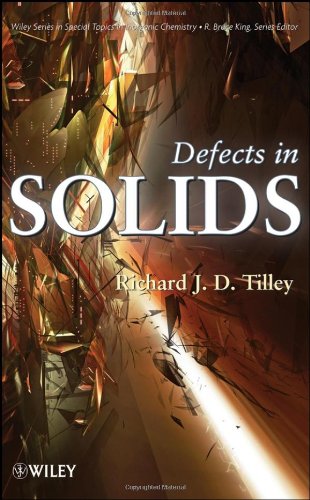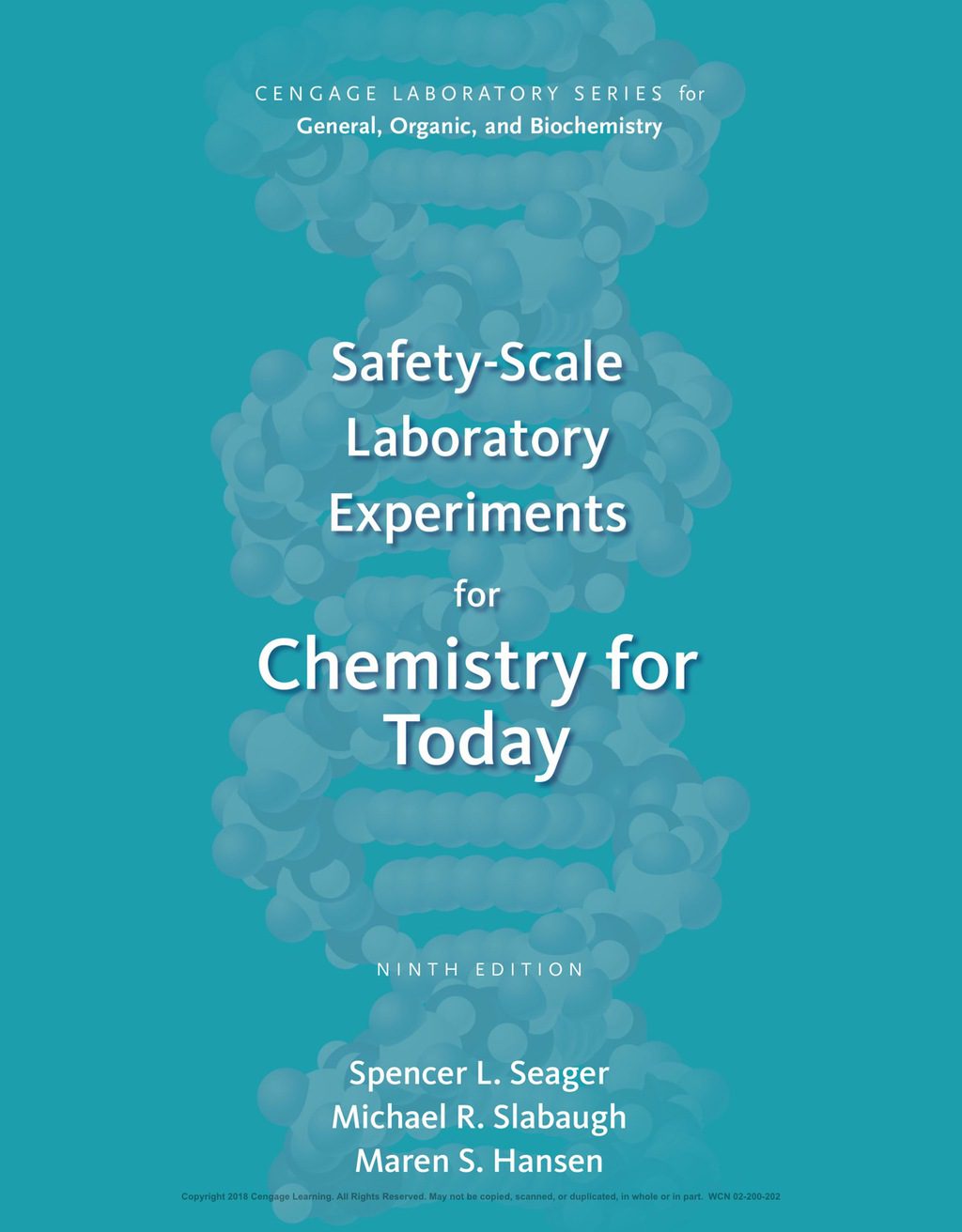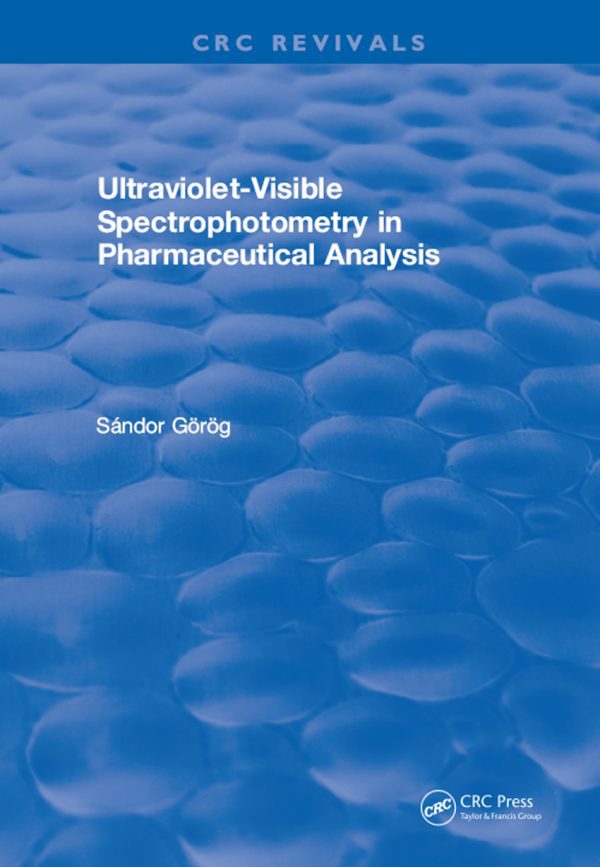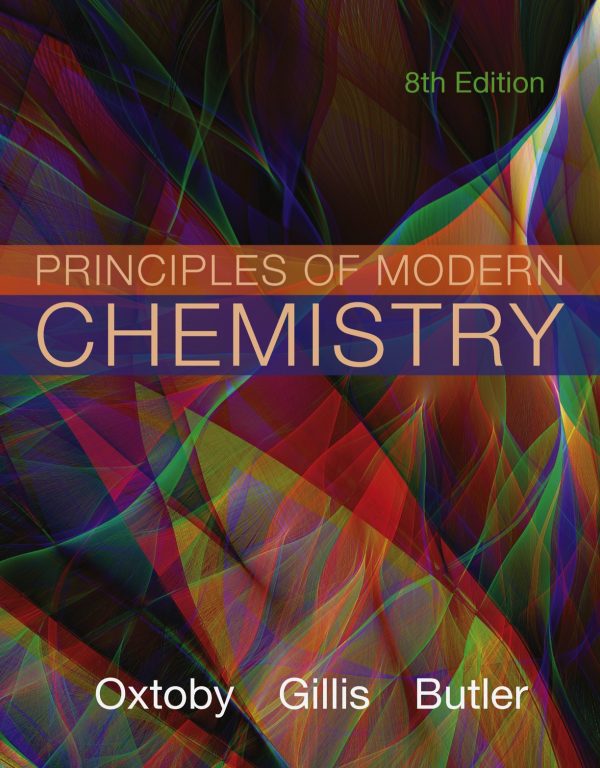Richard J. D. Tilley9780470077948, 0470077948
Table of contents :
DEFECTS IN SOLIDS……Page 3
CONTENTS……Page 9
Preface……Page 17
1.1 Introduction……Page 21
1.2 Point and Electronic Defects in Crystalline Solids……Page 24
1.3 Electronic Properties: Doped Silicon and Germanium as Examples……Page 27
1.4 Optical Properties: F Centers and Ruby as Examples……Page 30
1.5 Bulk Properties……Page 32
1.5.1 Unit Cell Dimensions……Page 33
1.5.2 Density……Page 34
1.5.3 Volume……Page 36
1.5.4 Young’s Modulus (the Elastic Modulus)……Page 37
1.6 Thermoelectric Properties: The Seebeck Coefficient as an Example……Page 38
1.7 Point Defect Notation……Page 40
1.8.1 Electrons and Electron Holes……Page 41
1.8.2 Atomic and Ionic Defects……Page 42
1.9.1 Schottky Defects……Page 45
1.9.2 Frenkel Defects……Page 47
1.10 Antisite Defects……Page 48
1.11.2 Equation Formalism……Page 51
1.11.4 Nickel Oxide……Page 53
1.11.5 Cadmium Oxide……Page 55
1.11.6 Calcia-stabilized Zirconia……Page 56
1.11.7 Ternary Oxides……Page 57
1.12 Combinations of Point Defects in Pure Materials……Page 58
1.13 Structural Consequences of Point Defect Populations……Page 59
1.14 Answers to Introductory Questions……Page 60
Problems and Exercises……Page 61
Further Reading……Page 64
2.1 Equilibrium Population of Vacancies in a Monatomic Crystal……Page 65
2.2 Equilibrium Population of Self-Interstitials in a Monatomic Crystal……Page 70
2.3 Equilibrium Population of Schottky Defects in a Crystal……Page 72
2.4 Lithium Iodide Battery……Page 74
2.5 Equilibrium Population of Frenkel Defects in a Crystal……Page 76
2.6 Photographic Film……Page 78
2.7 Photochromic Glasses……Page 82
2.8 Equilibrium Population of Antisite Defects in a Crystal……Page 84
2.9 Intrinsic Defects: Trends and Further Considerations……Page 85
2.10.1 Defect Calculations……Page 86
2.10.2 Point Defect Interactions……Page 88
2.10.3 Atomistic Simulation……Page 90
2.10.4 The Shell Model……Page 92
2.10.5 Defect Formation Energy……Page 95
2.10.6 Quantum Mechanical Calculations……Page 96
2.11 Answers to Introductory Questions……Page 97
Problems and Exercises……Page 98
Further Reading……Page 101
3.1 Dislocations……Page 103
3.2 Edge Dislocations……Page 105
3.3 Screw Dislocations……Page 110
3.4 Mixed Dislocations……Page 113
3.5 Unit and Partial Dislocations……Page 114
3.7.1 Dislocation Loops……Page 119
3.7.2 Dislocation Climb……Page 122
3.8 Dislocations in Nonmetallic Crystals……Page 123
3.9 Internal Boundaries……Page 127
3.10 Low-Angle Grain Boundaries……Page 128
3.11 Twin Boundaries……Page 130
3.12 Antiphase Boundaries……Page 134
3.13.1 Magnetic Structures……Page 136
3.13.2 Ferroelectric Structures……Page 138
3.13.3 Ferroic Structures……Page 139
3.14 External Surfaces and Grain Boundaries……Page 140
3.14.2 Electronic Properties of Interfaces……Page 142
3.14.3 Varistors……Page 144
3.14.4 Positive Temperature Coefficient Thermistors……Page 146
3.15 Volume Defects and Precipitates……Page 148
3.16 Answers to Introductory Questions……Page 149
Problems and Exercises……Page 151
Further Reading……Page 153
4.1.1 Phase Diagrams and the Coexistence of Solids……Page 155
4.1.3 Phase Diagrams and Composition……Page 157
4.2 Substitutional Solid Solutions……Page 160
4.3.1 Substitution: Gallium Arsenide, GaAs……Page 163
4.3.3 Interstitials: La(2)CuO(4) and Sr(2)CuO(2)F(2)……Page 165
4.3.5 Defect Variation: Zinc Oxide, ZnO……Page 167
4.3.6 Defect Spinels, M(2)O(3)……Page 168
4.4.1 Point Defect Aggregations……Page 169
4.4.2 Iron Oxide, Wu¨stite……Page 170
4.4.3 Hyperstoichiometric Uranium Dioxide……Page 172
4.4.4 Anion-Excess Fluorite Structures……Page 175
4.4.5 Anion-Deficient Fluorite Structures……Page 177
4.5 Interpolation……Page 181
4.6 Intercalation……Page 185
4.7 Linear Defects……Page 187
4.8 Modular Structures……Page 190
4.8.1 Crystallographic Shear Phases……Page 191
4.8.2 Twinning and Composition Variation……Page 196
4.8.3 Chemical Twinning……Page 197
4.8.4 Perovskite-Related Structures……Page 199
4.8.5 Misfit-Layer Compounds……Page 204
4.8.6 Niobium Pentoxide Block Structures……Page 207
4.9 Ordering and Assimilation……Page 210
4.10.1 Structure Modulations……Page 212
4.10.2 Yttrium Oxyfluoride and Related Structures……Page 213
4.10.3 U(3)O(8)-Related Structures……Page 215
4.10.4 Sr(x)TiS(3) and Related Structures……Page 216
4.11 Answers to Introductory Questions……Page 218
Problems and Exercises……Page 219
Further Reading……Page 222
5.1 Diffusion……Page 225
5.2 Diffusion in Solids……Page 227
5.3 Random-Walk Diffusion in Crystals……Page 233
5.4.1 Vacancy Diffusion……Page 236
5.4.3 Interstitialcy Diffusion……Page 237
5.4.4 Impurity and Cluster Diffusion Mechanisms……Page 239
5.4.5 Diffusion Paths……Page 241
5.6 Correlation Factors……Page 247
5.7 Temperature Variation of the Diffusion Coefficient……Page 251
5.8 Temperature Variation and Intrinsic Diffusion……Page 256
5.9 Diffusion Mechanisms and Impurities……Page 260
5.10 Chemical and Ambipolar Diffusion……Page 261
5.11 Dislocation and Grain Boundary Diffusion……Page 263
5.13 Answers to Introductory Questions……Page 265
Problems and Exercises……Page 266
Further Reading……Page 270
6.1.1 Ionic Conductivity in Solids……Page 271
6.1.2 Fundamental Concepts……Page 272
6.2.1 Random-Walk Model……Page 275
6.2.2 Relationship between Ionic Conductivity and Diffusion Coefficient……Page 279
6.2.3 Ionic Conductivity and Defects……Page 281
6.3 Impedance Measurements……Page 283
6.4 Electrochemical Cells and Batteries……Page 285
6.5 Disordered Cation Compounds……Page 288
6.6.1 Idealized Structures of the β-Alumina-Related Phases……Page 290
6.6.2 Defects in β-Alumina……Page 292
6.6.4 Ionic Conductivity……Page 294
6.6.5 Batteries Using β΄΄-Alumina……Page 296
6.7 Enhancement of Ionic Conductivity……Page 298
6.8.1 Structure and Oxygen Diffusion in Fluorite Structure Oxides……Page 300
6.8.2 Free Energy and Stoichiometry of Oxides……Page 301
6.8.3 Oxygen Sensors……Page 302
6.8.4 Oxygen Pumps and Coulometric Titrations……Page 304
6.9 Proton (H(+) Ion) Conductors……Page 305
6.10 Solid Oxide Fuel Cells……Page 307
6.11 Answers to Introductory Questions……Page 308
Problems and Exercises……Page 310
Further Reading……Page 314
7.1.1 Electronic and Ionic Compensation……Page 317
7.1.2 Metal-Excess Phases……Page 318
7.1.3 Oxygen-Excess Phases……Page 319
7.2.1 Conductivity and Defect Concentrations……Page 321
7.2.2 Holes, Electrons, and Valence……Page 322
7.2.3 Localized Electrons and Polarons……Page 323
7.2.4 Defects and Hopping Conductivity……Page 324
7.2.5 Band versus Hopping Conduction……Page 326
7.2.6 Seebeck Coefficient and Stoichiometry……Page 327
7.3.1 Equilibrium Partial Pressures……Page 329
7.3.2 Phase Rule……Page 332
7.4.1 Metal-Excess Oxides……Page 335
7.4.2 Oxygen-Excess Oxides……Page 337
7.4.3 Ba(2)In(2)O(5)……Page 338
7.5.1 Initial Assumptions……Page 340
7.5.2 Defect Equilibria……Page 341
7.5.3 Stoichiometric Point: Ionic Defects……Page 342
7.5.4 Near Stoichiometry: Ionic Defects……Page 344
7.5.5 High X(2) Partial Pressures: Ionic Defects……Page 346
7.5.6 Low X(2) Partial Pressures: Ionic Defects……Page 347
7.5.7 Complete Diagram: Ionic Defects……Page 348
7.6.1 Electronic Defects……Page 349
7.6.2 Near Stoichiometry: Electronic Defects……Page 350
7.6.3 High X(2) Partial Pressures: Electronic Defects……Page 353
7.6.4 Low X(2) Partial Pressures: Electronic Defects……Page 354
7.6.5 Complete Diagram: Electronic Defects……Page 355
7.7.1 Cr(2)O(3)……Page 356
7.7.2 Ba(2)In(2)O(5)……Page 358
7.8 Brouwer Diagrams: Effects of Temperature……Page 359
7.9.1 Ionic Defects……Page 360
7.9.2 Electronic Defects……Page 363
7.10 Answers to Introductory Questions……Page 364
Problems and Exercises……Page 365
Further Reading……Page 369
8.1 Effect of Impurity Atoms……Page 371
8.2.2 Donor Doping of Cr(2)O(3)……Page 372
8.2.3 Acceptor Doping……Page 373
8.2.4 Acceptor Doping of NiO……Page 374
8.3 Negative Temperature Coefficient (NTC) Thermistors……Page 375
8.4.1 Construction……Page 378
8.4.2 General Trends: MX……Page 380
8.5.1 Acceptor Doping into La(2)CuO(4)……Page 383
8.5.2 Donor Doping into Nd(2)CuO(4)……Page 385
8.5.3 Spinel System Li(1+x)Ti(2-x)O(4)……Page 386
8.6.1 Perovskite-Related Structures and Series……Page 387
8.6.2 Hole Doping……Page 390
8.6.3 Defect Structures……Page 393
8.7.1 Fluorite Structure Oxides: CeO(2-δ)……Page 398
8.7.2 Layered Structures: Li(x)MX(2)……Page 400
8.7.3 Acceptor Doping in Perovskite Structure Oxides……Page 401
8.8.1 Proton Mixed Conductors……Page 405
8.8.2 Brouwer Diagram Representation of Mixed Proton Conductivity……Page 407
8.8.3 Charge Carrier Map Representation of Mixed Conductivity……Page 409
8.9 Choice of Compensation Mechanism……Page 411
8.10 Answers to Introductory Questions……Page 412
Problems and Exercises……Page 414
Further Reading……Page 417
9.1 Magnetic Defects……Page 419
9.2 Magnetic Defects in Semiconductors……Page 423
9.3 Magnetic Defects in Ferrites……Page 425
9.4 Charge and Spin States in Cobaltites and Manganites……Page 426
9.5 Extended Magnetic Defects……Page 429
9.6.1 Absorption and Scattering……Page 432
9.6.2 Energy Levels……Page 433
9.6.3 Energy Levels in Solids……Page 436
9.7.1 Transition-Metal and Lanthanide Ion Colors……Page 437
9.7.2 Colors and Impurity Defects……Page 438
9.8.1 Energy Degradation and Down-conversion……Page 440
9.8.2 Up-conversion……Page 441
9.9.1 Emission of Radiation……Page 448
9.9.2 Ruby Laser: Three-Level Lasers……Page 449
9.9.3 Neodymium (Nd(3+)) Laser: Four-Level Lasers……Page 450
9.10.1 The F Center……Page 452
9.10.2 Electron and Hole Centers……Page 453
9.10.3 Surface Color Centers……Page 455
9.10.4 Complex Color Centers: Laser and Photonic Action……Page 456
9.11 Electrochromic Films……Page 458
9.12 Photoinduced Magnetism……Page 460
9.13 Answers to Introductory Questions……Page 461
Problems and Exercises……Page 463
Further Reading……Page 466
S1.1 Crystal Systems and Unit Cells……Page 467
S1.2 Crystal Planes and Miller Indices……Page 468
S1.3 Directions……Page 471
S1.4 Crystal Structures……Page 472
Further Reading……Page 480
S2.2 Insulators, Semiconductors and Metals……Page 481
S2.3 Point Defects and Energy Bands in Semiconductors and Insulators……Page 483
S2.4 Transition-Metal Oxides……Page 484
S3.1 Seebeck Coefficient and Entropy……Page 485
S3.2 Seebeck Coefficient and Defect Populations……Page 488
S4.1 Equilibrium Concentration of Schottky Defects Derived from Configurational Entropy……Page 490
S4.2 Stirling’s Approximation……Page 493
S4.3 Equilibrium Concentration of Frenkel Defects Derived from Configurational Entropy……Page 494
S5.2 Non-Steady-State Diffusion……Page 496
S5.3 Random-Walk Diffusion……Page 498
S5.4 Concentration Profile……Page 504
S5.5 Fick’s Laws and the Diffusion Equations……Page 505
S6.1 Atomic Magnetism……Page 509
S6.2 Types of Magnetic Material……Page 510
S6.3 Crystal Field Splitting……Page 512
Answers to Problems and Exercises……Page 515
Formula Index……Page 527
Subject Index……Page 533







Reviews
There are no reviews yet.